Guest Blog by Kathryn Adisman on Ghost Sites of Greenwich Village
Afterword by Steve Zeitlin and Molly Garfinkel
Collage by Elaine Norman
Poetry of Everyday Life Blogpost #22
Produced in collaboration with Voices: Journal of New York Folklore.
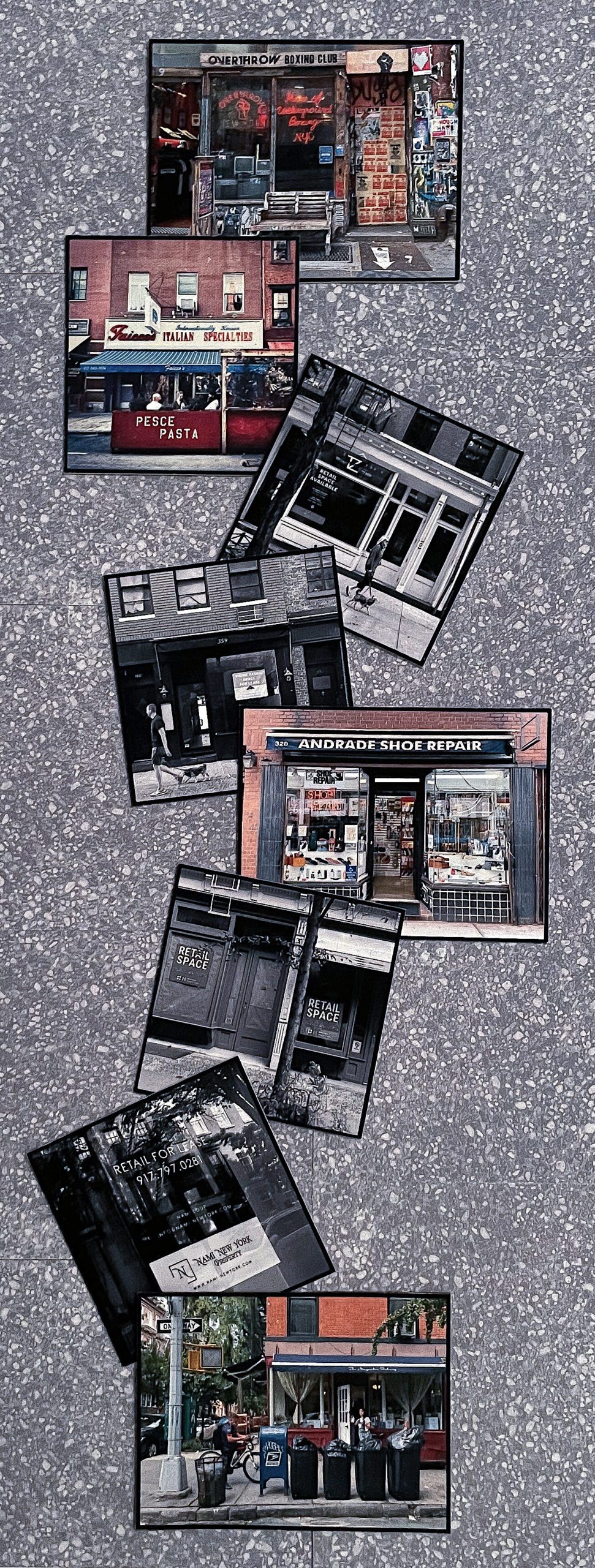
Anyone who has lived in New York for any time soon becomes aware of “Ghost Sites,” places too soon relegated to memory. As part of City Lore’s Place Matters project and the Census of Places that Matter, we struggle with how to think about and address vanishing sites, especially during this Covid era. Our longtime friend, writer Kathryn Adisman has a unique take on the subject and we invited her to contribute this guest blog for us, focusing, in part, on Bleecker Street in the West Village. In our Afterword and the accompanying collage by the artist Elaine Norman, we take a walk across Bleecker Street today.
INTRO: WHY WRITE A ‘GHOST CITY’ BLOG?
As the co-owner of Vegetable Garden on Bleecker Street said to me less than a week before his shop closed in 2005: “You can write about it all you want, it won’t change the outcome.”
He was right: I couldn’t change the outcome.
When a new crisis happens every day – resignation of NY’s longtime Governor, #MeToo movement, pandemic variants, Black Lives Matter, Taliban takeover, natural disasters caused by climate change, hate crimes, war in Ukraine … the list goes on (Did I leave something out? Only a little Texas law banning women’s reproductive rights, rewinding the clock on Roe v. Wade – Oh, that’s all!) – in the midst of everything demanding our attention now, why focus on lost places – things we can’t do anything about, that are in the past? What’s the point?
You might as well ask, What’s the point of our lives? It’s about leaving behind evidence of our existence. These places are us. Our NYC! They tell a story about what made New York, New York. After we’re gone, who will know there ever was a New York City with variety and “verve” – to quote another shop owner about what we are losing – if we don’t bear witness to its existence and paint a portrait of a time and place, as it’s passing?
What I am interested in preserving is my “relationship” with these unique places and the people behind them. This personal relationship is what’s lost when a local business is replaced by a national chain. There was a time on Bleecker Street when the places I loved had vanished, yet I still “saw” them with my New Yorker’s double vision, more vivid and real to me than what is really there. You could say I am haunted by these “ghost” sites; places that I once haunted now haunt me. BOO!
My whole life’s journey is a search for home, which I lost as a child and found in my “relationships” with places that are literally the ground beneath my feet. Homes away from home.
What makes me uniquely qualified to write about the city? For me, it’s personal. My mother’s family was in real estate, and my father was evicted by Donald Trump. The quintessential battle between landowner and shop owner is in my DNA. I am New York! I combine two categories of New Yorker E.B. White names in Here Is New York: the native and the settler. I am both a native who grew up on the grid of the Upper East Side and a settler who landed elsewhere: off the grid in Greenwich Village. In her memoir A Freewheelin’ Time, Suze Rotolo writes, “Greenwich Village is a calling.”
I answered the call!
***
PART I: OFF THE GRID
The first time I traveled Downtown from the Upper East Side, taking the subway by myself, age 11, to start 6th grade at Grace Church School, I fell in love with Greenwich Village and vowed, “When I grow up, I’m going to be a writer and live in the Village. Like Bob Dylan!”
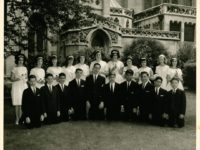
It took 20 years, but I kept my vow. To quote Edward Albee, “Sometimes, it’s necessary to go a long distance out of the way in order to come back a short distance correctly.”
That long distance took me as far away as Cambridge, England, The Midwest, and Baltimore where I’m nicknamed ‘The Walker’…. until NYU grad school calls me home. In 1982, my return coincides with New York’s real estate boom. I come back to a very different city from the one I left and settle in a very different neighborhood from the one I grew up in.…
I defected – Is there any other word for it? – from the grid. I became a denizen of this maze called the West Village, where streets have names and go off on an angle of their own. And where West 4th St. and West 10th St. can intersect.
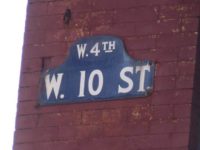
The most important thing to be said about the West Village is that it is Off the Grid that the rest of Manhattan was designed on and that I grew up within. No matter how many moves we made when I was a child – up and down Third Avenue to Forest Hills, Queens, to Park Avenue – we always remained inside the grid. But when I came back to “Noo Yawk” (my nickname in Ann Arbor!) after exile in “America” with nothing to show for it but a divorce and a Master’s in poetry, I took up residence off the grid, Downtown (can you hear the Petula Clark song? Siren call to teenage girls!). Symbolically, you could say I had disappeared off the face of the Earth, as my family knew it.
TRUDI OF THE WEST VILLAGE
Wandering the circular streets with my yellow pad of Post-Its – who am I, Trudi, the bag lady Lily Tomlin plays in A Search for Signs of Intelligent Life in the Universe, homing in on the psychic radar? I jot down cultural observations (a perfect mating of form and content – what are Post-Its but ephemeral pieces of paper doomed, like our times, to disappear?). I feel like that British artist Andy Goldsworthy who builds structures predestined to be short-lived, e.g., sand castles, then photographs them to preserve their mortal existence. I used to hate him for being a fraud. Now I understand; this is what I do – scrawl on scraps of paper words I can barely decipher, then attempt to save these fleeting thoughts by translating them into type, like I’m drawing on the cave walls.
“This is archaeology – what you’re trying to do,” said poet Ron Kolm, a night manager at Coliseum Books when I interviewed him in the last days of the iconic bookstore, January 2002, just four months after 9/11. Little did I know that I was about to become a habitual mourner at the wake of lost places.
It’s not nostalgia; it’s about bearing witness to the moment of departure, the moment things start to change, the moment “Twilight Becomes Night.”
That moment happens for me in October 2004 (Jeremiah Moss pinpoints almost the same exact geiger counter moment in Vanishing New York: How a Great City Lost Its Soul, as 2005) on the block of Bleecker Street known for its old-world charm, where there are more shops of every variety per square foot than anywhere else in the city – Ottamanelli & Sons Prime Meats, Faicco’s Italian Specialties, Pasticceria Bruno and Rocco’s Pastry, Bleecker St. Records, Second Childhood, Matt Umanov guitars – vintage shops that give the street its flavor, of which only two or three are left. I notice something. It’s a sign!
THIS IS MURRAY’S CHEESE, WHOLESALE, RETAIL, OLDEST, BEST
Murray’s, in its glossy reincarnation, faces its old gated self like an enormous funhouse mirror. It was a cheese shop, and it turned into a gourmet store. Murray’s wakes me up.
Compare streets to a neighborhood of teeth in a mouth. You can’t uproot one and put it across from where it used to be. That’s the dentist’s daughter talking. The new Murray’s stands out like a gold tooth in an old mouth. It’s abutted on one side by boarded up shops. I lose my bearings. Places are signposts. They orient us.
The New Yorker hyped the move in the same issue it mourned the closing of 80-year-old family-owned bakery, Zito & Sons.
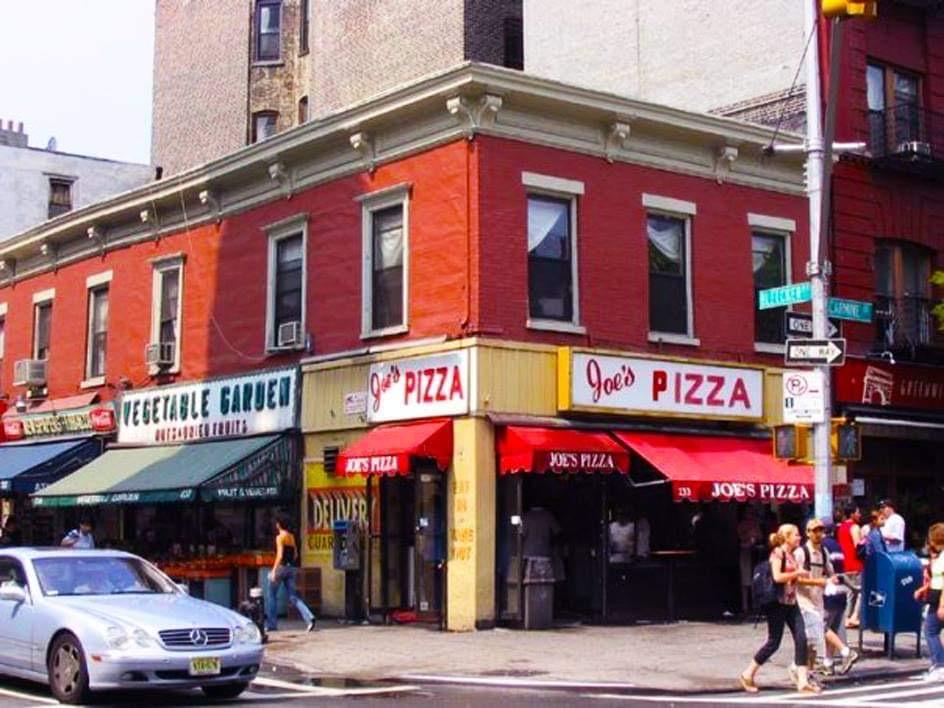
By February 2005, Vegetable Garden and neighbor Famous Joe’s Pizza, immortalized in Spider-Man 2, both vanished from the block. Joann Pelletiere, owner of Aphrodisia Herb Shoppe, a destination on the Downtown Loop, followed suit in 2010. Joann blames mayors Koch and Giuliani for selling Times Square out to developers, which led to relocated porn shops and tattoo parlors popping up around the corner on 6th Avenue, aka Avenue of the Americas, the main drag (pardon the pun) of the West Village.
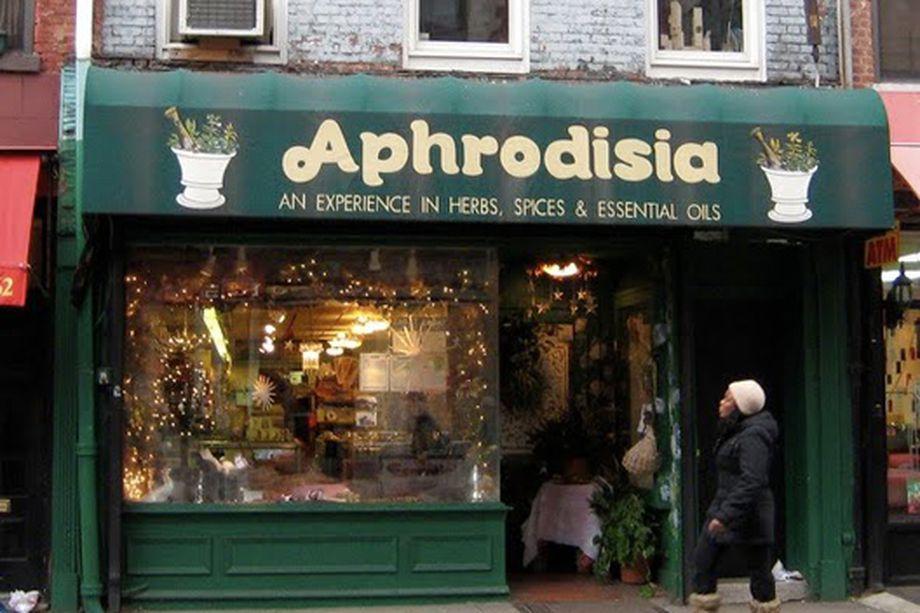
ON BLEECKER STREET
When I register the number of times I have traveled this route across town – this is my territory, stomping grounds, literally. More than any other street in the city, this street has felt the imprint of my feet trodding up and down, back and forth, almost the entire width of the island. Bleecker was my crosstown route to the gym, Coles Sports and Recreation Center on Mercer Street, also disappeared. It was on these walks that I got a pedestrian-eye view of all the sights along Bleecker Street and could peer down side streets like MacDougal to glimpse the coffee houses, comedy clubs, and night spots.
Bleecker cuts a swath through the village, a river of commerce and pedestrian traffic, from its source at Abingdon Square (the meeting of Hudson Street and 8th Avenue), where it wends its way leisurely, angling south and east, until it bottoms out—on the Bowery. Carried along in its current, I put on the hat of the Tour Guide. Follow me! Down the river. My Mississippi.

HOP ON a red double decker tour bus. Hear what stories the guide tells to the tourists. Did you know that …“Billy Joel got his start on Bleecker Street!”? “Robert De Niro grew up on Bleecker Street!”? “$30 pays your rent on Bleecker Street” in Simon & Garfunkel’s 1964 song?
It comes as a shock when my low-rise, “mixed use” – to quote urban pioneer Jane Jacobs – neighborhood is “discovered” overnight. I stare in disbelief as double decker tour buses disgorge passengers in front of Magnolia bakery and people line up for cupcakes the way they used to line up for Woody Allen movies. Blame it on “Sex and the City.” Who knew this boom would boomerang?
Biography Bookshop (whiff of old London) upholding the corner at West 11th Street and majestic Toons Thai restaurant holding down the corner at Bank Street like a pair of immovable pillars get swept away in a tsunami of designer boutiques. The old Bookshop was replaced by Marc Jacobs’ cleverly named Bookmarc, selling contemporary stuff: coffee table art books and New York-centric lit, esoterica, handbags and i-phone cases with the designer’s name, which he branded on the brick & mortar of his six shops – all except Bookmarc abandoned to shuttered storefronts, but not before altering the character of the block, once upon a time, Antique Row. Bookbook, Biography Bookshop’s reincarnation, gives up the ghost in 2019. BOO!
***
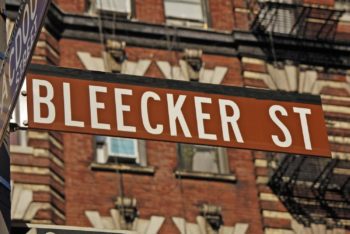
My first ever trip to Bleecker Street took place in the ’60s, ushered there by my uncle the flaneur and original Tour Guide. Uncle Richard introduced me to John’s of Bleecker Street “No Slices” (still here!), which he proclaimed “the best pizza in NYC!” This was tantamount to the official stamp of approval. My uncle was the self-appointed authority on everything. He didn’t have a job. His office was the NYPL, Main Branch. He patrolled the city in his trademark uniform of baseball cap and brolly, slung over one shoulder like a rifle. “Capitalism,” declared my uncle, “is the dragon that eats its own tail.”
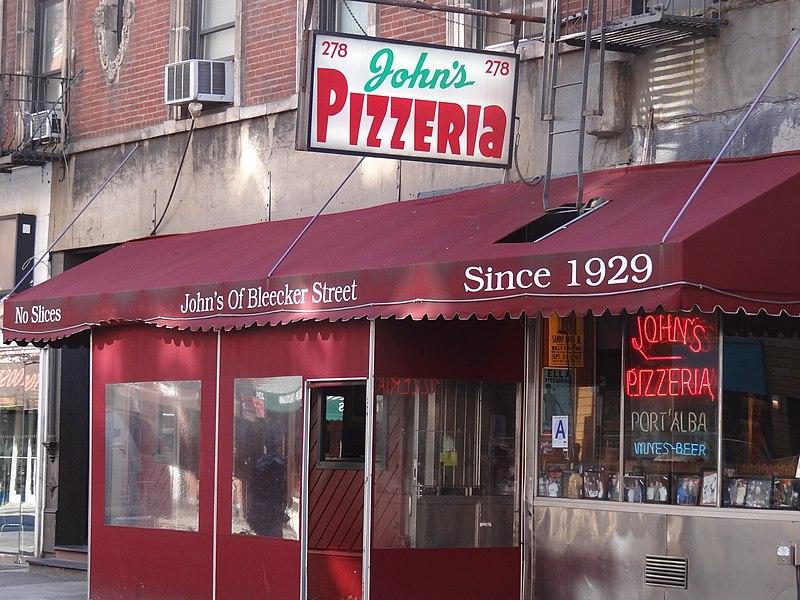
His words come back to me as I witness small businesses built by immigrants like my grandfather, who came here in search of the American Dream, get consumed by conglomerates. I find out that my own great grandfather lost his business to the Supermarket. I am the great granddaughter of a greengrocer!
VEGETABLE GARDEN
No wonder I’m drawn to the Portuguese greengrocer at the corner of Carmine across from Our Lady of Pompeii Church, overlooking Father Demo Square on 6th Avenue (gathering place for pigeons and pedestrians) in the “Italian” South Village – my favorite shop in the city until it gets priced out of existence.
“Nuts and Dried Fruits” says the sign above the storefront. Add freshly squeezed orange juice, gallon tins of olive oil, jars of artichoke hearts, canned ripe tomatoes, broa (Portuguese corn bread), BoraBora lemonade, La Squisita, Guaraná (Brazilian soda), bacalao (dry salted cod), and seasonal fresh fruits and vegetables – great produce at low prices for 31 years.
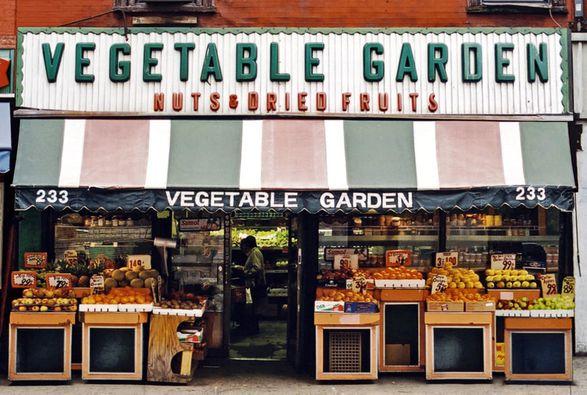
Like so many customers, I would come for the variety, as well as the unique product – canned Portuguese sardines. It was the only place in Manhattan I could find them in olive oil with skins. Abel would order them for me personally. There was a gruff charm in the way he seemed bemused by me: “The Sardine Lady.”
Co-owner Abel Ornelas embodied the shop, which smelled of the outdoors – of earth and life. The New York Times Metropolitan Diary even wrote about Abel – a greengrocer who quotes Plato!
“There’s people behind places,” said Coney Island USA’s Dick Zigun, who lost his place on the boardwalk in 1995. “The loss to the city is the loss of a certain type of person in the city.”
Abel’s family had roots on the block. Coming to this country in 1961 at 12, Abel lived around the corner on Carmine Street in a building that belonged to his uncle. He can remember when there were pushcarts on Bleecker Street. His whole life was encompassed by the store. He married his childhood sweetheart the same year the store opened.

The attraction of these small business owners—it’s visceral. Abel’s got that … charisma, which is common to entrepreneurs, going all the way back to the original prototype: my handsome, invincible Dad. He was James Bond and Superman to me, but he couldn’t conquer the real estate industry.
On the last day, following Ron Kolm’s advice – “The chain stores have their place, good for petty acts of sabotage” – I buy a throw away camera at CVS (in 2005 I don’t own a smartphone) to record the moment, as it’s passing. Here is an excerpt from my “Valentine to Vegetable Garden”:
Saturday, February 13, 2005. It’s the last day of Vegetable Garden, the only Portuguese greengrocer in the city, after 31 years on Bleecker Street, a neighborhood institution.
People from the neighborhood gather outside and weep. What they are mourning is not just the loss of a grocery but a relationship.
“They’re taking part of our life away, and we won’t find what they gave us here ever anywhere,” says an elderly customer, going on to describe her relationship with the store as a relationship with human beings who care, a phenomenon increasingly rare in the new box stores and online businesses.
It wasn’t about business, co-owner John (João) Pedro agrees. “It was about life outside the business.”
A man shakes Abel’s hand, formally. “Thank you for 30 years. I’ve been coming here since it opened.”
“It’s been a good run,” admits Abel.
Somebody asks if he plans to go back to Portugal.
“I’ve been here since I was a child. I’m American. This is my country.”
“How will we find you?”
“One day you’ll see a sign: ABEL’S BACK!”
Today an upscale chocolatier inhabits that corner. BOO!
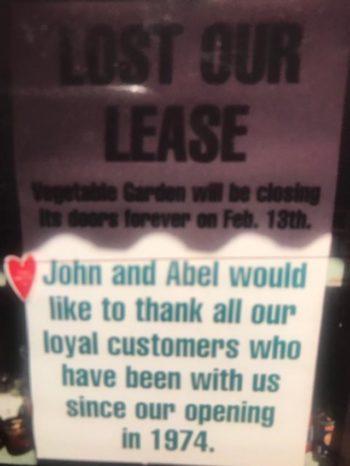
PART 2: VANISHING CITY, VANISHING DREAM
“‘Going out of business! Lost our lease! Everything must go!’ The signs tell the story.…” As long ago as 1996, I wrote my proposal for Vanishing City, Vanishing Dream, a book mapping the disappearance of NYC. By 2005, only a few signs remain. Alas, Bleecker Street is better known for what was here once upon a time.
Matching my own double vision, like existing in two time zones simultaneously, the sign above CVS pharmacy, at the corner of Thompson Street, signals another era when this was a block of world-class jazz clubs and theaters. The sign reads, “Art d’Lugoff’s Village Gate.” Ray Charles sang there. I saw Charles Mingus play there!
The only “sign” of what was once Circle in the Square, an Off-Broadway theater, was the lower façade, otherwise unrecognizable after it was renovated into a modern apartment building by NYU, the biggest landlord in the Village. Further east, a colorful cardboard cut-out sign was all that’s left of Kim’s Video Underground (former site of Bleecker Street Theater), gutted, and soon to be replaced by another branch of the drug chain with a name like a country-western star: Duane Reade.

Places like the Village Gate and CBGB on the Bowery can never be replaced; history was housed here, they were theatres of musical events, a live performance happened every night of the week. All that will be left is the signs.
***
CAFFE DANTE – Sidetrip to MacDougal, east of 6th Avenue
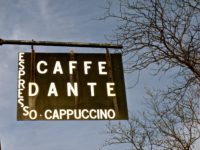
The black & white shingle hung out over the street greets you like a Welcome Home sign … No Wi-Fi! You’re stepping into another century…
Who can forget the little Italian ladies who sit in the window of the old Caffe Dante at the front table with the sign that says: RESERVED. I always wondered who it was reserved for.
“Us,” says Babe.
Sondheim can have his ladies who lunch; my ladies drink espresso with their gossip, the backs of their heads silhouetted in the store window as in a painting. They’re part of the place. The round table at Caffe Dante was the Algonquin of Greenwich Village.
Their fame spread to the Upper East Side. At Lennox Hill Hospital, Babe overheard a man telling his mother about this café where the ladies go every day. Babe said: “That’s me. I’m one of the ladies.”
It’s Babe who always said hello to me. Who’d commiserate on my quitting smoking. Caffe Dante was one of the last places in the city (like La Bonbonniere diner in the West Village) where you could still smoke.
Once upon a time, there were 10 at the reserved table, but by the end, there were only three. Babe and Eugenia and Jo … known each other 62 years. Neighbors in the same building. They reminded me of The Fates, spinning their tales of this one and that one. I lurk in my corner table in the back, as much of a character as they are. I have joined the ranks unknown artists and writers who arrived in the Village from small towns in America; the only difference being that I come from the big town of another Manhattan, which looked askance on this one.

A week before it closed, longtime owner Mario Flotta, who should have been cast in a Martin Scorcese movie, was still denying it. But it was already gone – renovated past recognition, a ghost of its old self. In 2015 it got sold to Australians and changed its name from Caffe Dante to Dante, along with its menu and prices. The sign still hangs, but it no longer beckons me. Today’s Dante has outdoor seating in (gasp!) white wicker chairs. What would the ladies say?! BOO!
***
CORNELIA STREET CAFE

Cornelia Street, a small side street west of 6th Avenue, between Bleecker and West 4th, was home to one of my old haunts – a Greenwich Village institution that was here before me. It started as a hole in the wall with a toaster oven rented by three artists in 1977 and became “a culinary as well as a cultural landmark.” Recognized by its signature peppermint-striped awning and red doors – the bar, restaurant and cabaret known as ‘The Cornelia Street Café,’ whose eclectic offerings ranged from science to songwriting (where Suzanne Vega got her start and Eve Ensler launched “The Vagina Monologues” and where I saw John Oliver and David Amram perform), was bigger than the chunk of real estate it occupied. It was a beacon for the arts, community gathering place and vital venue for spoken word and jazz, giving many artists a voice, of which I was one. When it closed January 2, 2019, it felt like a light had gone out in the city.
My relationship with the café begins inauspiciously in 1985 when my friend from Baltimore Michael “Toes” Tiranoff, another “settler,” who worked there as a dishwasher while studying Tap with Brenda Bufalino, gets me a job waiting tables (before Lady Gaga!). The job doesn’t last (I’m fired for spilling capuccino on customers at the sidewalk tables), but my relationship with the cafe continues: from waitron to patron in the upstairs restaurant (safe bet to invite family from Uptown or friends from Out of Town – charming Bohemian but not “way out”) and reader-performer in the cabaret Underground.
I don’t know what I’m getting into when I pitch “Tapping into New York,” a show combining memoir and tap dance, with Toes in mind, figuring I’ll never hear back. The next day, the “Minister of Culture,” who happened to be the owner and a writer himself, Robin Hirsch, replies: “Marvelous notion! I’m forwarding it to my curators.” He welcomed the famous and the nobodies. I’m one of the nobodies. To my shock, I get offered a date for a gig. But Toes isn’t available. Naively, I assume I’ll read my memoir and the café will handle the rest. I’m quickly informed: “We do 700 shows/year – That’s your job!”
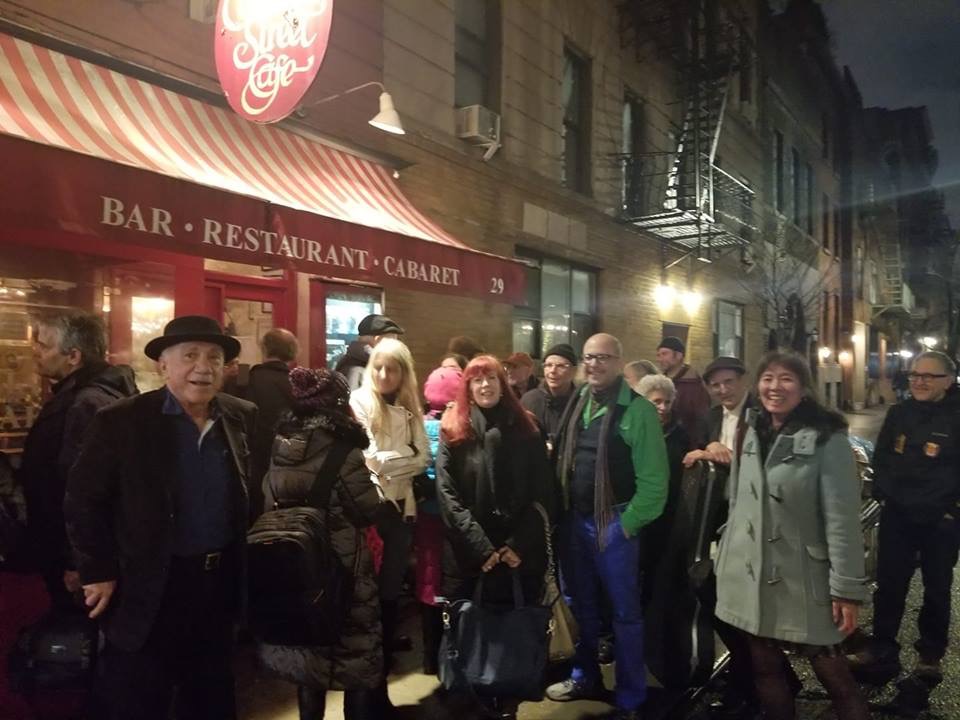
So, that’s how I find myself producing, curating, and hosting shows, including “What Were the ’60s REALLY Like?” Inspired by a real question my kid half brother, Bill Levine, asked me and by Bob Zimmerman, aka Dylan, being awarded the Nobel prize in literature, the series debuted on Trump’s Inauguration Day. (And a ’60s child shall lead them I amNewYork)
When Cornelia Street Café’s neighbor Caffe Vivaldi on Jones Street closes June 2018, it’s a sign. Our last series, titled prophetically, “Ghost City Cabaret,” with your g-Host, K, not to be confused with “Cabaret” emcee Joel Grey or TV horror host Zacherly, ends December 21, 2018, days before the café – after 41 ½ years! – vanishes. Three years later, the space remains empty, the colorful awning furled – another “ghost” site. BOO!
***
*******************************
GHOST SITES – AN AFTERWORD
Colson Whitehead, like Kathryn Adisman, was struck by the presence of Ghost Sites in New York. “No matter how long you have been here,” he writes in The Colossus of New York, “you are a New Yorker the first time you say that used to be Munsey’s or that used to be the Tic Toc Lounge…. You are a New Yorker when what was there before is more real and solid that what is here now.”
In many ways, New York is a different city every ten years. Preventing one’s presence from being built-over to accommodate new narratives or structures (whether architectural, social, political, or financial) is a continual challenge in the urban environment. This rapid change means that places—whether individual buildings, blocks, neighborhoods or whole boroughs—are like palimpsests, ancient manuscripts or parchments used as writing material. Palimpsests contained text that was scraped off so that the piece could be reused, leaving traces of earlier verses, ideas, stories, and identities still visible, if not legible, in the parchment.”
A few days ago, Steve walked the length of Bleecker with photographer Elaine Norman.
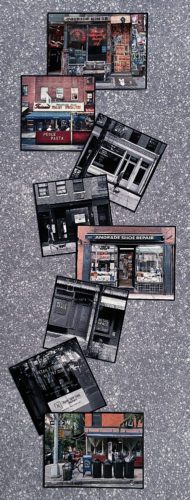
There is evidence that Bleecker is attempting a comeback. Certainly, the West Side of Bleecker, gentrified by Magnolia Bakery, whose cupcakes were made famous by “Sex and the City” is now lined with empty storefronts where high prices have left “Retail Space for Lease” signs on window after window. Yet thankfully, the East Side and center of Bleecker still houses Overthrow Boxing, the marvelous Bessou restaurant, the revamped but still extant Murray’s Cheese, the Bitter End, even a shoe repair shop and a crammed-in bookstore, Codex. But the only way to truly appreciate the vitality of the city is to give equal weight to the neighborhood’s past and its sometimes vital, sometimes shabby present. Grasp the vivid, touchable present, while keeping an eye on the shadows from the past. Walking on Bleecker Street, check out the present storefronts that cast the shadows, the ghost sites. Appreciate them equally with Kathryn’s “New York” eyes.
With past/present vision, we walk our New York streets re-membering the dismembered city blocks – the present day storefronts are brick and mortar, the rest are interior streetscapes of vanished sites populated with memories, places we need to reconstruct from the gossamer threads of remembrance to create architecture for the soul.
Steve Zeitlin and Molly Garfinkel







2 thoughts on “K’s Ghost City: Haunted by New York’s Vanished Sites”
In 1975, when I was new to NYC, the artist Lucia Vernarelli would take me food shopping on Bleecker Street. We would walk eastward along Bleecker Street from Abingdon Square. Food, its preparation, presentation, and its sharing were an important part of Lucia’s art. We would walk all the way to Carmine Street and then turn around, stopping at Vegetable Garden, Zito’s, several fish stores, the Italian specialties stores, Ottomanellis. I felt privileged to be given this insider’s view of the Village. Sometimes we would also stop on the way back at Opera Foods on Abingdon Square.
Did you ever read “Bleecker Street” by the poet Jean Garrigue? It seems to be about that particular stretch of Bleecker Street. It’s a love poem about shopping for someone there but it’s also a love poem about that part of the street itself. I think she is referencing Our Lady of Pompeii Church and Vegetable Garden when she writes “The American flag set out in bulbs —… to advertise a church bazaar by backs of Spanish melons ?” Further on a reference to Ottomanelli’s — “where the lamb hangs in his wool”
Glad you wrote this, Kathryn.